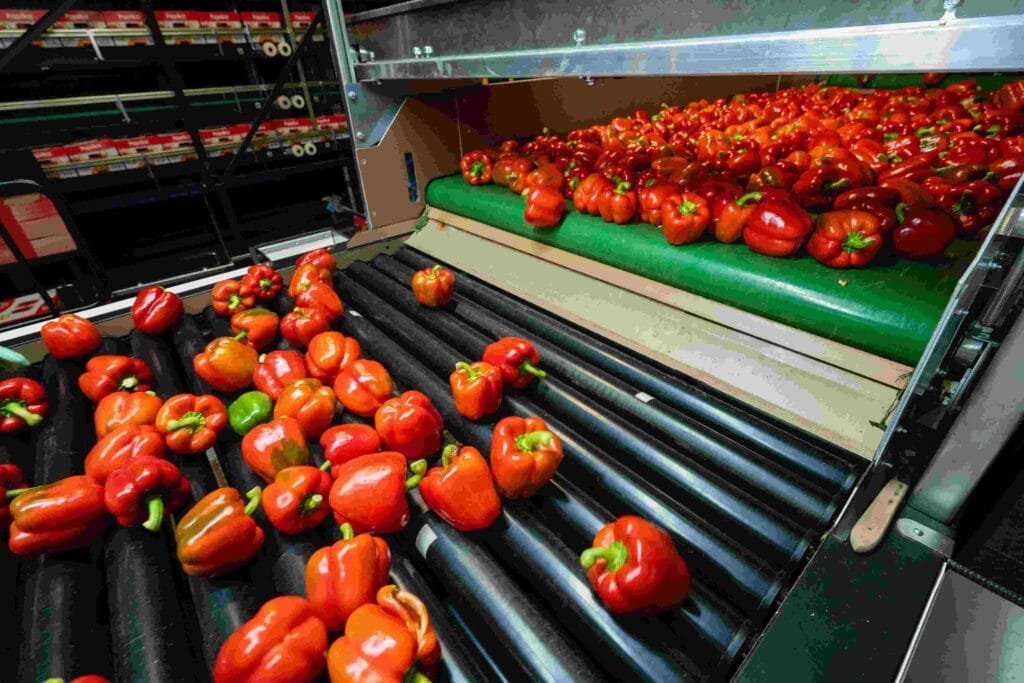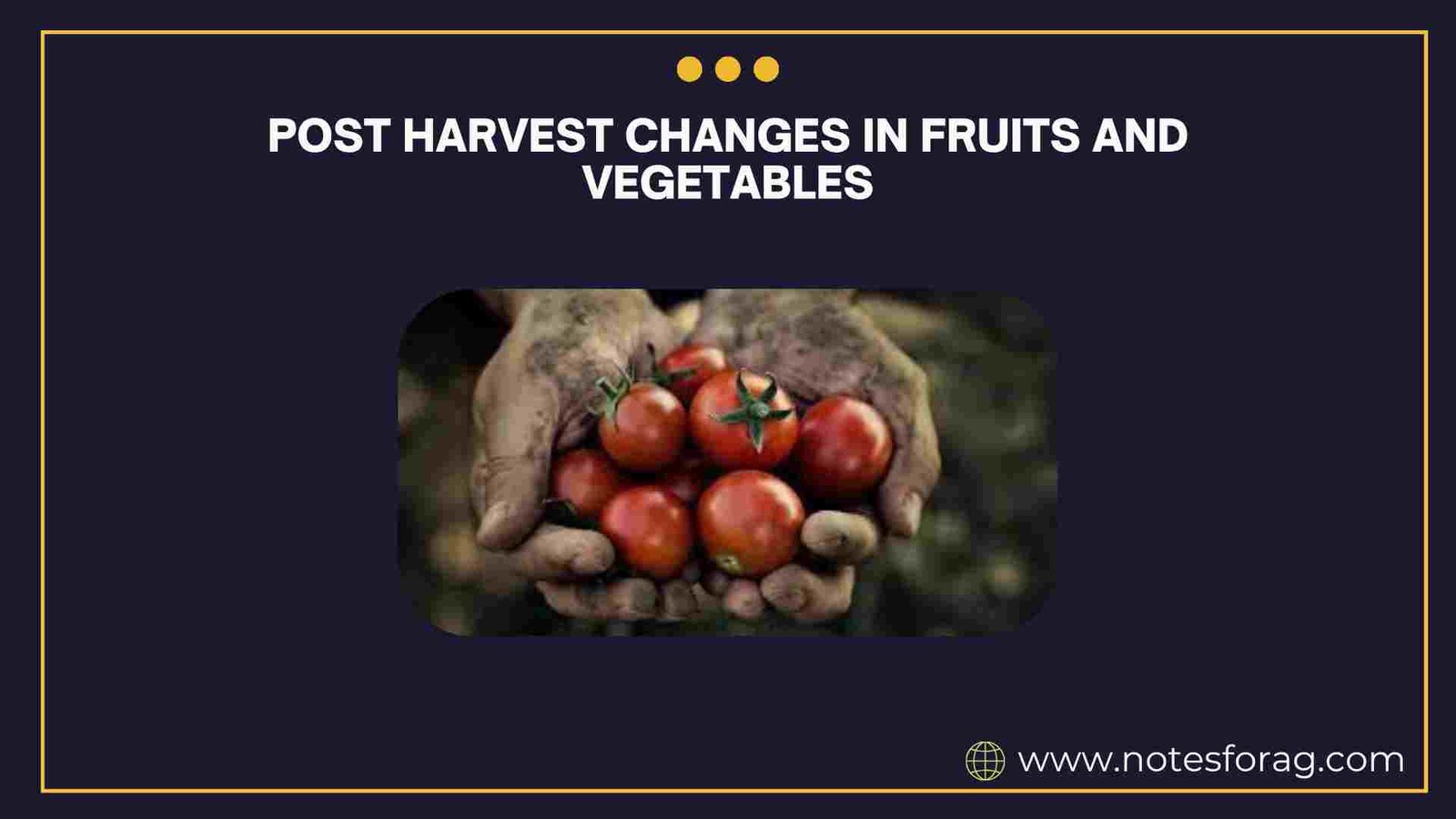Introduction to Post Harvest Changes
Post-harvest change refers to the natural physical, chemical, and biological processes that occur in fruits and vegetables after they are harvested. These changes include respiration, moisture loss, ripening, softening, color and flavor alteration, nutrient degradation, and microbial spoilage.
After fruits and vegetables are harvested, they undergo a series of physical, chemical, and biological changes. These changes, known as post harvest changes, can affect the texture, color, flavor, nutritional content, and overall quality of the produce. Understanding these transformations is essential for farmers, supply chain managers, food processors, and consumers, as they directly impact shelf life, market value, and food safety. The goal of post harvest handling is to slow down deterioration, reduce losses, and preserve quality until the produce reaches consumers.

Summary of Post harvest changes
- After harvest, fruits and vegetables undergo natural physiological, biochemical, and microbial changes that lead to moisture loss, ripening, softening, and spoilage, significantly affecting their quality and shelf life.
- Factors like temperature, humidity, ethylene exposure, and mechanical damage play a crucial role in accelerating or slowing post harvest changes; proper handling and packaging are essential to minimize losses.
- Modern post harvest technologies such as cold chain management, controlled atmosphere storage, chemical treatments, and biological control help preserve freshness, reduce waste, and maintain nutritional value from farm to consumer.
Table of Contents
Types of Post Harvest Changes
Physiological Changes
After harvest, fruits and vegetables remain biologically active. They continue to respire, transpire, and metabolize, which leads to several physiological changes. Respiration is a key factor, as it converts stored sugars into energy, resulting in the release of carbon dioxide and water. This process generates heat and accelerates senescence (aging), especially in highly perishable produce like berries and leafy greens. Another physiological change is transpiration, which causes moisture loss and results in wilting, shriveling, and loss of crispness. Additionally, ethylene production in some fruits, like bananas and apples, promotes ripening and softening but can also cause over-ripening and spoilage if not controlled.
Biochemical Changes
Biochemical changes involve the breakdown and synthesis of various molecules, significantly influencing the taste, color, and nutritional content of the produce. Enzymatic activity increases post harvest, causing changes such as starch converting to sugar in bananas or pectin breakdown leading to fruit softening. Pigments like chlorophyll degrade, resulting in color changes from green to yellow or red. Similarly, antioxidant levels and vitamin content can either increase or decline depending on the produce and storage conditions. These changes can enhance or reduce the edibility and market appeal of fruits and vegetables.
Microbial Changes
Microorganisms such as bacteria, fungi, and yeasts can grow on fruits and vegetables after harvest, especially if the produce is damaged or exposed to high humidity. Spoilage microorganisms cause rotting, discoloration, and off-odors. Fungal infections, such as those caused by Botrytis or Penicillium, are common in strawberries, grapes, and citrus fruits. Some microbes produce mycotoxins that are harmful to humans. Hence, proper handling, sanitation, and storage are critical to minimize microbial growth and ensure food safety.
Specific Changes in Fruits

Ripening
Ripening is a natural post harvest process in climacteric fruits like mango, papaya, and tomato, where ethylene production increases respiration and accelerates sugar accumulation, pigment changes, and aroma development. Non-climacteric fruits like grapes and citrus do not continue ripening once harvested, so their post harvest changes are minimal in this regard. However, color and flavor may still alter slightly during storage.
Softening
Fruit softening is caused by the breakdown of cell wall components, particularly pectin and hemicellulose, due to increased enzymatic activity. While softening improves palatability in ripe fruits like peaches and bananas, excessive softening results in textural degradation and reduced market value.
Color and Flavor Changes
Color change in fruits is often due to chlorophyll degradation and synthesis of carotenoids or anthocyanins. For example, the green peel of a banana turns yellow as chlorophyll breaks down. Similarly, flavor changes result from sugar accumulation, acid degradation, and formation of aromatic volatiles. These changes make the fruit more appealing to consumers but can also indicate nearing spoilage if unmanaged.
Specific Changes in Vegetables

Wilting and Shriveling
Vegetables, especially leafy greens and root crops, are highly prone to water loss through transpiration. As water is lost, tissues lose turgor pressure, resulting in wilting and shriveling. This not only affects appearance but also reduces weight, firmness, and freshness.
Toughening and Lignification
In some vegetables like asparagus and carrots, post-harvest storage can lead to lignification, where cell walls thicken due to lignin accumulation. This toughens the texture and decreases palatability. High storage temperatures and prolonged storage times accelerate this process.
Nutrient Degradation
Post-harvest nutrient loss is a major concern, particularly for vitamin C and B-complex vitamins, which are sensitive to temperature and light. Prolonged exposure to air and improper storage can lead to significant declines in nutritional quality. For example, spinach can lose up to 90% of its vitamin C content within 24 hours of harvest if not stored properly.
Factors Affecting Post Harvest Changes
Temperature
Temperature plays a pivotal role in regulating respiration, enzymatic activity, and microbial growth. Cold storage slows down metabolic processes and preserves freshness. However, excessively low temperatures can cause chilling injury in sensitive fruits like mangoes and bananas, leading to pitting, discoloration, and poor flavor development.
Relative Humidity
Maintaining optimal relative humidity is crucial to prevent water loss and wilting. High humidity (85 to 95 percent) is ideal for most vegetables and some fruits but can promote microbial growth if not balanced with adequate air circulation. Low humidity accelerates desiccation and textural changes.
Ethylene Exposure
Ethylene is a plant hormone that accelerates ripening and senescence. Fruits and vegetables should be stored based on their ethylene sensitivity. For example, ethylene-producing apples should not be stored near ethylene-sensitive greens like lettuce or broccoli, as it may cause yellowing or spoilage.
Mechanical Damage
Bruising, cuts, and abrasions during harvesting, handling, or transport compromise the protective skin of produce and create entry points for microbes. Damaged tissues also show increased respiration and enzymatic browning, leading to quality degradation and reduced shelf life.
Packaging and Handling
Proper packaging minimizes physical damage, maintains humidity, and can help regulate gas composition. Modified atmosphere packaging (MAP) and vacuum sealing are commonly used to slow down respiration and extend shelf life. Gentle handling reduces bruising and contamination risk, making training and awareness essential for workers.
Post Harvest Technologies to Reduce Changes
Cold Chain Management
Cold chain involves maintaining a consistent low temperature from the field to the market. It is the most effective strategy to delay post-harvest changes and extend shelf life. Pre-cooling immediately after harvest helps remove field heat, while refrigerated storage and transport reduce metabolic rates and microbial activity.
Controlled Atmosphere Storage
Controlled atmosphere (CA) storage alters the composition of gases (oxygen, carbon dioxide, and nitrogen) around the produce to slow respiration and delay ripening. For example, reducing oxygen levels to 2 to 5 percent and increasing CO2 slows down ethylene action in apples and extends storage life without compromising flavor.
Chemical Treatments
Post-harvest chemical treatments, such as fungicides, wax coatings, and ethylene inhibitors like 1-MCP, are used to delay spoilage and enhance shelf life. Wax coatings reduce moisture loss and enhance appearance, especially in citrus fruits and apples. Ethylene inhibitors block ripening in climacteric fruits during storage.
Radiation and Irradiation
Radiation, particularly gamma irradiation, is used to disinfect produce, kill pests, and delay ripening by inhibiting cellular activity. It is approved for use in many countries and is safe within recommended doses. This method extends shelf life without leaving residues.
Biological Control
Biological agents such as beneficial bacteria or fungi can be used to suppress pathogens that cause post-harvest decay. For example, certain strains of Bacillus and Trichoderma are used to control fungal rots in fruits like grapes and strawberries.
Economic and Nutritional Implications
Post-harvest losses significantly impact the agricultural economy. In many developing countries, up to 30 to 40 percent of fruits and vegetables are lost due to inadequate storage and transport. These losses represent not just wasted food, but also wasted water, energy, labor, and investment. From a nutritional perspective, degradation in vitamins, antioxidants, and phytochemicals reduces the health benefits of fruits and vegetables, making their timely and proper consumption critical.
Consumer Awareness and Role
Consumers play a vital role in minimizing post-harvest losses by practicing proper storage at home, choosing undamaged produce, and using fruits and vegetables promptly. Awareness about optimal storage conditions, like keeping tomatoes at room temperature or wrapping greens in moist paper towels, can extend freshness and reduce food waste. Reading labels, understanding expiration dates, and supporting local and seasonal produce can also contribute to reducing losses.
Conclusion
Post harvest changes in fruits and vegetables are complex and influenced by various biological, environmental, and human factors. These changes can degrade the quality, safety, and nutritional value of produce if not managed correctly. By understanding the physiological, biochemical, and microbial transformations that occur after harvest, stakeholders across the supply chain, from farmers to consumers, can take effective steps to reduce spoilage, improve shelf life, and ensure better food security. With advancements in storage, packaging, and handling technologies, combined with increased awareness and education, it is possible to significantly minimize post-harvest losses and deliver high-quality produce to consumers around the world.
Frequently Asked Questions (FAQs)
How does humidity affect the quality of stored vegetables and fruits?
Keeping products in high humidity environments (85–95%) prevents wilting and weight loss, although too much moisture without airflow can promote mold and spoilage .
Why is temperature control important after harvesting produce?
Temperature heavily influences respiration, decay, and biochemical reactions. Cooler temperatures slow metabolism and bacterial growth, while improper cold can cause chilling injury in sensitive crops
What are the main types of post-harvest changes in fruits and vegetables?
Fruits and vegetables undergo three major post-harvest changes physiological (like respiration, moisture loss, and ethylene-triggered ripening), biochemical (such as color and flavor transformations), and microbial (including bacterial and fungal decay) .
Related Articles

